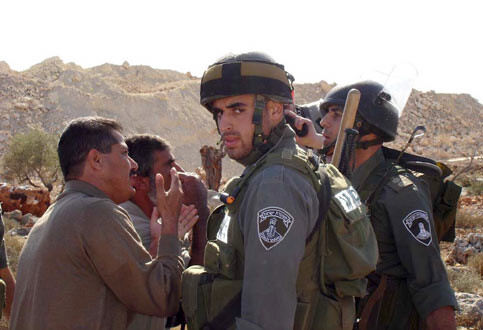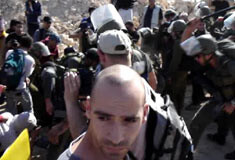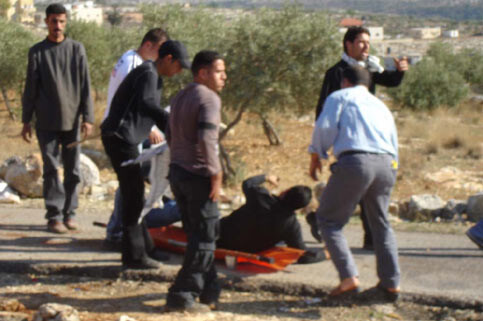The Electronic Intifada 18 November 2005

Fully aware that the weekly protests are non-violent, the Israeli military stood at the construction site of the wall, prepared to confront the approaching demonstrators. (Khaled Sabawi)
On Friday November 11th 2005, the residence of the Palestinian village of Bil’in, along with international and Israeli activists, rallied at the center of the village to prepare for their weekly act of civil disobedience and non-violent protest. Bil’in was once a small peaceful village located high on the hills of Palestine, inside the West Bank and north of Jerusalem.
For thirty-eight years, a brutal Israeli military occupation has subjected the village of Bil’in, along with the entire West Bank, to unrelenting violence, seizures, curfews, and land appropriations that have violated the Palestinian peoples’ basic civil and human rights. The residents of Bil’in are now embroiled in constant struggle, diligently attempting to use civil disobedience as a form of nonviolent resistance against the expansion of Israel’s illegal wall and settlements, which are rapidly confiscating what remains of their already truncated olive groves and farm land.
For two years now, the state of Israel has been building a chilling “separation wall”, 8 meters high and 650 km long, of pure concrete and electric fencing that zigzags deep into the West Bank confiscating land, sometimes five or six kilometers at a stretch.
Declared “in contravention of international law” by the International Court of Justice, the highest judicial body of the United Nations, this ghastly wall, along with its trenches, moats, and electric fencing, is still undergoing rapid construction in the West Bank. Although Israel claims the wall is being constructed for “security reasons”, it is built on 80% of Palestinian land inside the West Bank, annexing large portions of what remains of a putative Palestinian state.
The wall has now reached the village of Bil’in, threatening to cut the villagers off from two thirds of their land. Every Friday, after the Muslim community prayer, the villagers of Bil’in march to demonstrate against the violation of their human rights by the formidable Israeli military. Once enough demonstrators gathered at the center of Bil’in, we began our steady march to the location where the wall is under construction.

“So why are you here with guns forcing me out of my land?” (Khaled Sabawi)
As we made our way through the village, we joined the Palestinian protesters carrying signs, chanting and singing songs in English, Arabic, and Hebrew against the wall. Glancing at the hills in front of us, we could see the wall as it snakes through Bil’in, permanently altering its beautiful landscape.
As we approached the construction site of the wall, beyond the trenches and the rubble left behind from uprooted olive trees, we could see the Israeli military. Fully aware that the weekly protests are nonviolent, the Israeli military stood at the construction site of the wall, prepared to confront the approaching demonstrators. We finally reached the construction site. As a sign of protest, several international and Israeli activists sat down in front of the construction vehicles to temporarily interfere with construction of the wall.
The nonviolent strategy was well understood by all demonstrators, especially the Palestinians, who peacefully protested and chanted alongside. Some of the internationals confronted the Israeli soldiers, challenging the legitimacy of the wall and the Jewish-only settlements, the construction of which is in direct violation of article 49 of the Fourth Geneva Convention.
The apparently un-Semitic features of some of the Israeli soldiers prompted us to question their origin, in which some willingly answered: Poland, Russia, and Bulgaria. A Palestinian standing behind us immediately asked: “So why are you here with guns forcing me out of my land?”. One of the Israeli soldiers then stepped towards the questioning Palestinian in an attacking motion threatening to hurt him for questioning the soldiers, reminding the Palestinian of his formidable power. Palestinians must be extremely careful at such protests as they are frequently beaten and arrested by Israeli soldiers without charge.
According to B’Tselem, the Israeli Information Center for Human Rights in the Occupied Territories, there are currently 596 Palestinians in administrative detention, that is, detention without charge or trial, authorized by administrative order rather than by judicial decree[1]. B’tselem also reports that “Israel’s use of administrative detention blatantly violates” restrictions placed under international law[2].
Our peaceful demonstration continued as we chanted together against the wall and the occupation; not a stone was cast, not a soldier was threatened in any way. Suddenly, all hell broke loose. The Israeli soldiers received the order and unexpectedly began severely beating the international and Israeli demonstrators. Stun grenades and teargas canisters were launched at us as the soldiers rushed to attack the area. Explosions and smoke filled air. Hysteria spread as the peaceful protestor attempted to scatter, however, some were unable to escape.
The activists that were peacefully sitting down in front of the construction vehicles had their hair viciously pulled, faces scratched until they bled, and their bodies kicked and beaten as they lay helplessly terrified on the ground. A young Israeli woman was in severe pain after taking a baton to the throat and above the eye. Everyone was stunned.
Adamant not to grant the Israeli soldiers justification for their excessive use of violence, in the midst of the madness, the Palestinian demonstrators valiantly yelled “DO NOT THROW STONES!”. Several activists were hit with teargas canisters and were so overwhelmed by the teargas that they began to scream, vomit, choke, and even collapse. This included the chairman of the Bil’in council, who actually lost consciousness due to the gas. We frantically carried out every one that had collapsed as teargas infested the air.
For those that have fortunately not experienced the sting of a lachrymatory chemical agent such as teargas, the effects include incapacitation through irritation of eyes and/or respiratory system, rapidly producing disabling phsyical effects. The burning sensation felt in the eyes and respiratory system is haunting. Determined to continue our protest, some of us regrouped near a main road where the soldiers had dragged some of the activists over the sharp stones that covered the ground.

Screenshot video. (Khaled Sabawi)

Screenshot video. (Khaled Sabawi)
Although many of us were still recovering for a state of shock, we managed to restore the calm and continue our nonviolent struggle. In no way were the Israeli soldiers threatened; their use of violence was completely unjustified. This is confirmed by a statement made by the leader of Israel’s Bloc for Peace, Uri Avnery, who was amongst the demonstrators: “I was in the middle of the demo, less than a meter from the soldiers. I can testify with absolute certainty that there was no provocation whatsoever”[3].
When we confronted the soldiers and challenged their use of violence they responded “we are just following orders”. We continued our demonstration, singing and chanting, defying the provocation of the Israeli soldiers. This lasted for approximately 45 minutes.
As we maintained our strategy, resisting peacefully, it became clear that the Israeli military was preparing for something new. The soldiers began loading their M-16 rifles with rubber-coated metal bullet cannisters and once again, without warning, the soldiers went mad. This time it was far worse; the soldiers focused their punishment on the Palestinians. The soldiers cocked their rifles and began firing live ammunition at a group of Palestinians standing behind us.

Wounded protester on a stretcher. (Khaled Sabawi)
Rubber-coated metal bullets can cause severe injury and can be deadly at close range. The soldiers charged another group of Palestinian demonstrators. They randomly grabbed one Palestinian man and began severely beating him, finally dragging him across the ground as his sobbing wife ran out screaming from her nearby home. The soldiers pushed the wife away as she hopelessly pleaded for her husband’s release. It was an appalling sight. This is when, and only when, did the Palestinian youth retaliate by throwing stones. More soldiers arrived taking up a sniping post on a high mount of earth as other soldiers dispersed through the olive groves. The military appeared as if they were invading a notorious enemy force as they fired at the unarmed Palestinian youth.
One 14 year-old Palestinian boy was shot directly in the head with a rubber-coated metal bullet. He lay, heavily bleeding on the ground, as teargas canisters exploded near the Palestinians that ran to carry him way. A red-crescent ambulance then rushed in to rescue the boy. In an attempt to stop the chaos, some international and Israeli activists attempted to negotiated the release of the Palestinian man who was beaten and arrested. In return we promised to end the demonstration.
Joined by the Palestinian man’s elderly mother, we successfully convinced the Israeli commander to release the Palestinian man. This raises the question as to why this Palestinian man was detained in the first place. Once the demonstration was officially over, we returned to the center of the village, contemplating whether or not our non-violent demonstration actually achieved anything.
For one year now, the residence of Bil’in have been holding peaceful demonstrations every week, yet Israel continues to confiscate their land, expand its settlements, and build its wall without a word from the international community. This is paving the way for Israel’s full domination of Palestinians in the West Bank or what Israeli professor, Jeff Halper, refers to as “full-blown apartheid”[4].
Khaled Al Sabawi is a 22-year-old Canadian student from the University of Waterloo (UW) in Canada. He is currently in Ramallah, on a 4-month work term. He is a founding member and former President of Students For Palestinian Rights (SFPR) at the University of Waterloo.
Endnotes
[1] Statistics on Administrative Detention, B’Tselem.
[3] Gush Shalom, The Army Lies Again: Border Guard Attacked Non-Violent Demonstration
[4] Setting Up Abbas, Jeff Halper (25 October 2005)
Related Links


